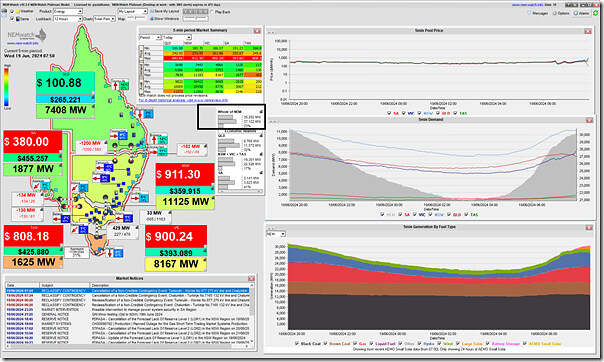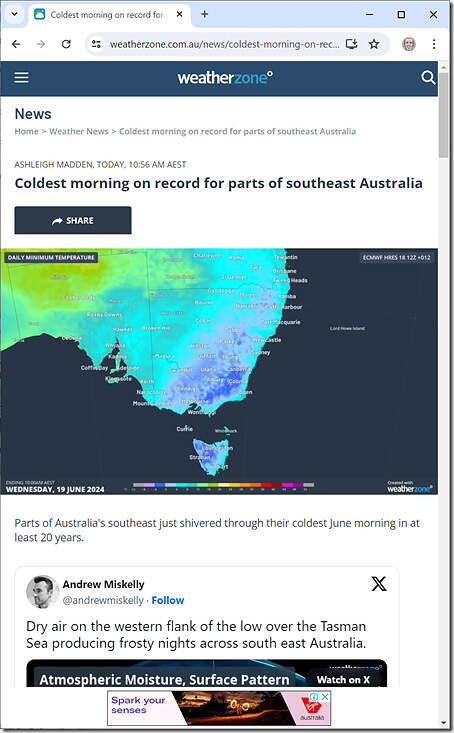A short article as a placeholder and memory-jogger that we might come back to later, as this snapshot from NEMwatch at 07:50 shows NEM-wide ‘Market Demand’ up at 30,202MW:
I don’t have time right now to scan systematically, but I don’t recall too many instances where demand on winter mornings has been as high as that in recent years?
At this time we have, in terms of contribution from VRE:
1) Aggregate wind production 1,164MW FinalMW
2) Aggregate large solar production 1,510MW FinalMW
3) Estimates from AEMO for small solar are published on a lag, so I don’t know, at this point.
We might come back to this later (e.g. for GenInsights Quarterly Updates for 2024 Q2) and look in more detail at metrics such as Aggregate Scheduled Target, as an indicator of the ongoing requirement for firming capacity.
PS1 … Weatherzone reports ‘coldest morning on record…’
Helping to explain what happened this morning, Ashleigh Madden from Weatherzone has posted ‘Coldest morning on record for parts of southeast Australia’:
There’s quite a few locational records noted in the article, but just singling out two:
‘> Melbourne recorded its coldest morning in nearly two years, with a minimum of 1.4°C
> Melbourne airport recorded the equal coldest June morning since 1996, with a minimum of 0.2°C’
… no wonder morning ‘Market Demand’ in the Victorian region was up in the yellow zone, on the NEMwatch snapshot above.




So let me get this right. We have wind at about 10% capacity factor for 12 hours, no solar (its night) and the nasty coal and gas have probably delivered 250GWhr overnight. So, let’s just assume we ended the 18th with full batteries – each with about 250MW of inverters and 2500MWhr of storage and we have 100 of them – the lights might still be on when the sun comes up…..and then we need to not only need to supply the higher daytime load but also have enough spare to recharge the batteries to do it all again. And this is before we try to “electrify everything” and as a minimum shift an increasing proportion of liquid transport fuel energy into electric energy stored in EV’s ready for the daily commute. Even if the 127,000MW of wind proposed (shown in the AEMO forecasts) gets built and it behaves like this we have spent a truckload of money and we still have a problem. I must be missing something again.
You’re right Paul that 30202 MW is a record for NEM-wide AM demand, at least in the last 15 years. But not far above the previous record from last year of 29996 MW on 21/6/2023 at 7:45. Andrew makes an interesting point in his comment about “how will this be done in future?” My view is that the “electrification of everything” will be part of the solution rather than part of the problem. If I’ve got an EV in the driveway with 50kWh in the tank, wouldn’t I be ready to sell some of that for of $0.70/kWh (=this morning’s spot price of $700/MWh)? Governments should be legislating a new FiT to motivate people to plug in their cars like we all plugged in our rooftop PV. They should not be spending a truckload of money to duplicate infrastructure that people will end up buying anyway (at least, a version with four wheels attached). Forget 100 grid-scale batteries, and imagine a couple of million cars.